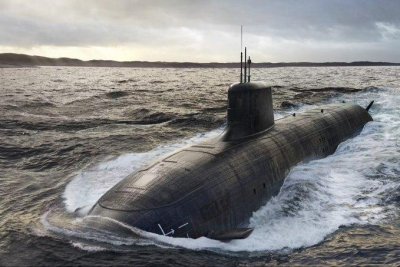
A concept image of one of 12 newly announced Submersible Nuclear Ships (SSN), in development under the AUKUS security pact, as part of a major overhaul of Britain’s strategic defense published on Monday. Photo courtesy U.K. Government
June 2 (UPI) — British Prime Minister Keir Starmer announced plans Monday to inject an additional $20.3 billion into the country’s nuclear weapons program to combat the “threat from Russia” and China and build 12 new nuclear-powered attack submarines.
The new spending is part of a major Strategic Defense Review unveiled by Starmer at a military contractor on Clydeside in Scotland, home to the country’s Trident submarine nuclear deterrent, aimed at restoring Britain’s fighting capability and making it “war-ready” within two years for a conflict in Europe and/or the Atlantic.
“We are moving to war-fighting readiness as the central purpose of our armed forces. When we are being directly threatened by states with advanced military forces, the most effective way to deter them is to be ready, and frankly, to show them that we’re ready to deliver peace through strength,” Starmer said.
“I believe the best way to deter conflict is to prepare for it.”
The plan, was Starmer said, “a blueprint to make Britain safer and stronger, a battle-ready, bomber-clad nation with the strongest alliances and the most advanced capabilities, equipped for the decades to come.”
However, he stressed that it would be a “NATO first” policy, putting the military alliance at the center of everything the United Kingdom did.
In addition to the nuclear warheads program and submarines, which will be built under the AUKUS security pact signed in 2021, other review pledges include six new munitions plants and adding 7,000 new long-range weapons to Britain’s arsenal, a “hybrid” Royal Navy that uses drones alongside warships, submarines and aircraft and invest in improved housing and equipment for members of the armed forces.
While Starmer said he was unable to give assurances that defense spending would reach the government’s goal 3% of GDP by 2034, everything in the defense blueprint was deliverable within the 2.5% figure the government committed to in February, due by Fiscal Year 2027.
Britain’s fiscal year runs April 1 through March 31.
The government has promised $12 billion of the $20 billion will come from economic growth, rather than spending cuts or tax hikes.
The 3% is an “ambition,” and the government’s refusal to set a firm timeline, and again tying it in with economic growth, raised eyebrows.
Starmer rejected suggestions that the failure to commit to a 3.5% minimum by 2032 called for by Secretary-General Mark Rutte and others, demonstrated a lack of commitment to the 32-member-country alliance.
The SDR was slammed by both the opposition Conservatives and the Liberal Democrats.
“With the prime minister unable to even confirm a date for hitting 3% on defense spending, the SDR really is unravelling. How can they deliver what they’ve promised?” Shadow Defense Secretary James Cartledge wrote on X.
Conservative leader Kemi Badenoch accused Starmer’s ruling Labour Party of not being able to “even hold a defense policy together for 48 hours.”
“How can they be trusted to defend Britain? In the most dangerous era in a generation, they found BILLIONS for the Chagos surrender — but can’t commit to properly funding our armed forces,” she wrote in a social media post.
Writing on X, Helen Maguire, defense spokesperson for the Liberal Democrats, called for all-party negotiations to agree on a path forward to 3% of GDP.
“Whilst the prime minister is totally right to recognize the importance of increasing our defense capabilities — without a clear spending plan — the SDR risks becoming a damp squib,” she said.